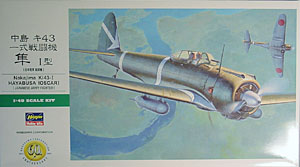Hasegawa 1/48 Nakajima Ki.43-I Hayabusa ("Oscar") | | History In 1937 the Japanese Army Air Force (JAAF) contracted directly with Nakajima Hikoki K. K., without competitive bid, for a single seat fighter to replace that company's Ki.27 ("Nate") as their principle fighter. It was to be faster than, and as maneuverable as, its predecessor. Initially the Ki.43 Hayabusa (Peregrine Falcon) did not meet the Army's maneuverability expectations. The fitment of "Combat Maneuvering Flaps" (the kit instructions call them "Butterfly Flaps") solved this problem enabling the plane to pull tight high "G" turns without stalling. These flaps deployed aft of the inner trailing edge of the wing at a slightly depressed angle thus simultaneously increasing the wing area, reducing the wing loading and increasing the average camber of the wing. They could also be used as take off and landing flaps. When first encountered by the Allies the Hayabusa was given two code names by Colonel McCoy's Allied Technical Air Intelligence unit (ATAIU) until it was realized that the "Jim" of the China-Burma-India Theater was the same plane as the Southwest Pacific's "Oscar". "Oscar" prevailed and "Jim" was dropped. Three main models of Oscar served with the JAAF: Ki.43-Ia, Ki.43-IIb and Ki.43-IIIa. The "Ki.” incidentally, is pronounced "Key", not "Kay-Eye", and is a contraction of the Japanese word "Kitai" pronounced "Key-Tie", which means "Airframe". At a glance the three Oscars are very similar. The Ki.43-I, with which we are here concerned, is the most distinctive for it had a two-bladed (license-built) Hamilton-Standard constant speed prop, a very pronounced chin intake for the carburetor and a ring-type oil cooler in front of the engine within the engine cowling. Less noticeable, its wingspan was about two feet greater than its successors in the series. Numerically, Oscar was the most important fighter deployed by the JAAF in WWII. It was in service before the war started and was still, albeit obsolescent, serving in great numbers at war's end. It was active in every theater in which the Japanese Army fought. It was also used by Japan's allies in Asia: The Manchuko puppet state's Manchu National Military Force Air Corps, the National Government of China puppet state's Air Force and Thailand's Royal Thai Air Force. Immediately post war, the Thais and the Nationalist (Chiang Kai Shek) Chinese used them as did the Indonesians in their fight for independence from the Dutch. The Armee' de L' Aire used them against the Viet Minh in French Indo China until their Bearcat replacements became available. Today, I believe, only two complete airframes survive: Ki.43-I, s/n 750, owned and restored to operating condition, but not flown, by the Alpine Fighter Collection in Wanaka on New Zealand's South Island and a Ki.43-II Otsu owned by the NASM and partially restored and displayed by the Experimental Aircraft Association in their museum at Oshkosh, Wisconsin. This latter airplane being an amalgam of parts from several airframes has no s/n. Four Oscars in various states of preservation reside in Australian museums and one in an Indonesian museum. The Texas Airplane Factory near Dallas is currently building four Oscar replicas. 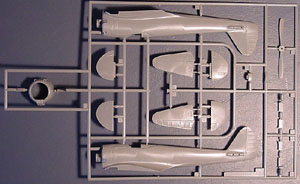 The Kit The Kit
It is immediately apparent from the breakdown of the kit's parts that we will see Ki.43-IIs and -IIIs as future releases. This is both good and bad news. Good, because it will give us the opportunity to do all three of the basic types plus minor variations and bad because of the way Hasegawa have chosen to handle that not quite two feet difference in wingspan. Alternate wing tips we would expect, but we would not expect them to cut through the ailerons. Fortunately they placed the join line on an aileron rib and on a wing panel line, which will simplify the necessary business of filling and filing this joint. I suspect the easiest way to deal with this poorly chosen joint is to separate the four aileron parts from the five wing and tip parts and assemble the ailerons separately for reinstallation at final assembly. Clearly, in my opinion, this is a case where Hasegawa should have made the ailerons, as well as the wing tips, separate parts. 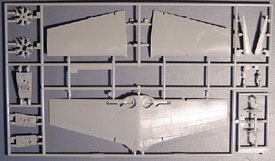 Otherwise, everything about this kit is superlative in the usual Hasegawa manner. Engineering is conventional. Cockpit detail, save for the typical absence of belts to keep the pilot in his seat, is complete. The separate injection molded windscreen and canopy hood are thin enough to use. A major annoyance, at least to me, is the slot in the windscreen to sit down over the telescopic gunsight. Couldn't we, please, have a hole instead? These darned slots are a bear to fill neatly! Another pet peeve is stabilizers and elevators molded as one piece. As far as I could learn, Oscar had no internal control locks, so the elevators droop when the plane is static on the ground. It will be difficult to separate the elevator from the stabilizer on this model because of the deep set mass balance areas ahead of the elevator hinge line. I usually address such problems by repeatedly and heavily, but slowly, scribing along the line between the two surfaces from both sides with the back edge of a #11 blade until the parts separate. Otherwise, everything about this kit is superlative in the usual Hasegawa manner. Engineering is conventional. Cockpit detail, save for the typical absence of belts to keep the pilot in his seat, is complete. The separate injection molded windscreen and canopy hood are thin enough to use. A major annoyance, at least to me, is the slot in the windscreen to sit down over the telescopic gunsight. Couldn't we, please, have a hole instead? These darned slots are a bear to fill neatly! Another pet peeve is stabilizers and elevators molded as one piece. As far as I could learn, Oscar had no internal control locks, so the elevators droop when the plane is static on the ground. It will be difficult to separate the elevator from the stabilizer on this model because of the deep set mass balance areas ahead of the elevator hinge line. I usually address such problems by repeatedly and heavily, but slowly, scribing along the line between the two surfaces from both sides with the back edge of a #11 blade until the parts separate.
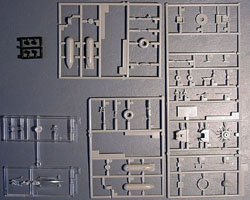 The kit comprises: 60 parts exquisitely injection molded in Hasegawa's standard light gray styrene sans warps and sink marks; three parts injection molded in clear styrene; four poly-vinyl collars; a beautifully printed decal sheet in perfect register and a four-fold, eight panel sheet containing a history, a parts map, a color guide, assembly instructions and a painting guide for two rather plain color schemes. Oscars had a large number of interesting color schemes over their long service career. Consult your reference materials for more interesting schemes. The kit comprises: 60 parts exquisitely injection molded in Hasegawa's standard light gray styrene sans warps and sink marks; three parts injection molded in clear styrene; four poly-vinyl collars; a beautifully printed decal sheet in perfect register and a four-fold, eight panel sheet containing a history, a parts map, a color guide, assembly instructions and a painting guide for two rather plain color schemes. Oscars had a large number of interesting color schemes over their long service career. Consult your reference materials for more interesting schemes.
The front of the fuselage, where it mates with the engine cowling, has a small step around its perimeter that should not be there. Fill and file as required to eliminate it and thin the trailing edges of the cowl flaps for a more accurate appearance and fit relationship between the fuselage and the engine cowling. One of the clear parts in the kit is a landing light lens for the left wing. As the Ki.43-I had no landing light the instructions tell you to paint over this lens. You should also fill the joint and the scribed lines around the lens before you paint. 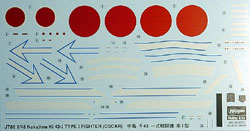 If you wish to pose the canopy hood open, you should fill the recess in the fuselage that accommodates the thickness of the hood and thin the lower inside edges of the clear hood to permit it to sit snugly on the rear deck. You'll also have to fabricate the inner structure of the rear of the hood from wire. Consult your references for the details of this bracing structure made of small diameter rods. If you wish to pose the canopy hood open, you should fill the recess in the fuselage that accommodates the thickness of the hood and thin the lower inside edges of the clear hood to permit it to sit snugly on the rear deck. You'll also have to fabricate the inner structure of the rear of the hood from wire. Consult your references for the details of this bracing structure made of small diameter rods.
Conclusion All things considered this is a very good kit. It's not perfect, but it is very good, except for those damned ailerons and that slotted windscreen. An especially nice touch is the realistically thin propeller blades that look like they could actually work as propeller blades. It's definitely much better than the old (25 years?) 48th scale Nichimo kit. References Japanese Aircraft Of The Pacific War: Rene J. Francillon, Putnam, London, 1970, ISBN 370-00033-1. Aero Detail #29 Nakajima Ki.43 "Oscar" Hayabusa: Edited by Art Box Co., Ltd. , Published by Dai Nippon Kaiga Co., Tokyo, 2000, ISBN 4-499-22735-6. Japanese Army Air Force Camouflage And Markings - World War Two: Donald W. Thorpe, Aero Publishers, Fallbrook, CA, 1968, Library of Congress 68-54880. Famous Airplanes Of The World - Army Type 1 Fighter "Hayabusa": (re issued three times between January 1972 and November 1988) by the editors of Koku-Fan, published by Bunrin-Do, Tokyo. Arco Aircam Aviation series - No. 15, Nakajima Ki.43 Hayabusa I-III In Japanese Army Air Force - RTAF-CAF-IPSF Service: Richard M. Bueschel, Arco, New York, 1970, ISBN 668-02292-2. Profile Number 46 (Red Series), The Nakajima Ki.43 Hayabusa: Martin C. Windrow & R. J. Francillon, Profile Pubs, Leatherhead, UK. Warplanes Of The Second World War - Fighters - Volume 3: William Green, Doubleday, New York, 1961. The Japanese Wings Of The Second World War: published by the Light Corporation, Tokyo, 1972. Japanese Army Aircraft Colours & Markings In The Pacific War - and Before: Ian k. Baker, Self published, Victoria, Australia, 1972, ISBN 0-646-10618X. Ian K. Baker's Aviation History Coloring Book No.38 - Imperial Japanese Army Aircraft Colour Schemes, Camouflage & Markings, Part 1, 1937-1945: Ian K. Baker, Self published, Victoria, Australia, 1999, ISSN 1322-0217. Part 2 is No. 39. Japanese Aircraft Interiors 1940-1945: Robert C. Mikesh, Monogram, Sturbridge, MA, 2000, ISBN 0-914144-61-8. Monogram Close-Up 14, Japanese Cockpit Interiors, Part 1: Robert C. Mikesh, Monogram, Boyleston, MA, 1976, ISBN 0914144-14-6. Camouflage And Markings Of Imperial Japanese Army Fighters: Model Art no. 384, 1981. Broken Wings Of The Samurai: Robert C. Mikesh, Naval Institute Press, Annapolis, 1993, ISBN 1-55750-083-5. Further, there is a Maru-Mechanic and the Aireview book on JAAf aircraft that I can’t find right now in my boxes of packed away books. |


 




|
